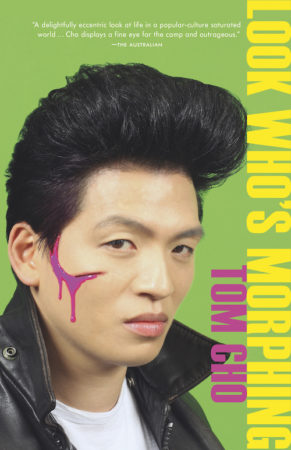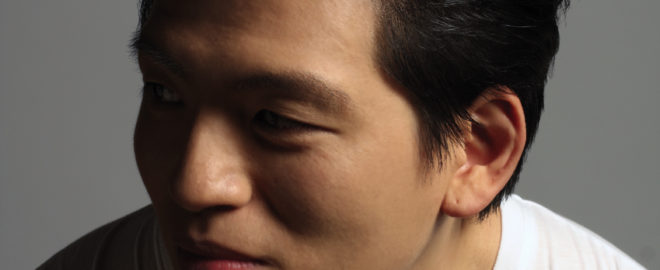Tom Cho’s current project is a novel about the meaning of life. His collection of fictions Look Who’s Morphing was published in North America by Arsenal Pulp Press and in Australia by Giramondo, and was shortlisted for multiple awards, including the Commonwealth Writers’ Prize for Best First Book. Tom has over 70 stories published in outlets such as The Best Australian Stories series, Electric Literature’s Recommended Reading, and others. Originally from Naarm (Melbourne, Australia), he is now based in Tkaronto (Toronto, Canada).
“‘Morphing’ has been a persistent concern of my fiction-writing practice. It’s been a theme of interest, as shown by the shape-shifting of the narrator in Look Who’s Morphing, my collection of fictions. But more importantly, morphing is my dominant creative strategy: I refashion texts and genres by displacing them from their usual contexts and diverting them into new contexts.”
IG: @robotom5000, Twitter: @Tom_Cho, Facebook
 Q&A with Tom Cho (from Crosstown Arts newsletter, January 18, 2022)
Q&A with Tom Cho (from Crosstown Arts newsletter, January 18, 2022)
Crosstown Arts residency alumnus Tom Cho is the author of the collection of fictions Look Who’s Morphing, published in North America by Arsenal Pulp Press and in Australia by Giramondo, and shortlisted for multiple awards. Tom also has over 80 fiction pieces published in journals and anthologies such as The Best Australian Stories series, Electric Literature’s Recommended Reading, and others. His current writing project is a novel that mashes up fiction, pop culture, philosophy of religion, and much more. Originally from Naarm (Melbourne, Australia), he is now based in Tkarón:to (Toronto, Canada). His website is at tomcho.com.
Crosstown Arts registrar Jesse Butcher caught up with Tom to discuss his love of pop culture, Sweet Valley High fandom, his relationship with the Tom of Finland Foundation, and his musical practice.
Jesse: Your debut fiction collection, Look Who’s Morphing, follows a multifaceted narrator through an insatiable, disentangled, and resituated world filled with pop culture manifestations. Suzie Quatro, Whitney Houston, and Mikey from Look Who’s Talking appear alongside many others in curious and hilarious scenarios. I’m interested in your relationship with pop culture. When composing this work, were you working from nostalgic memories of your lived experience, or was the process more researched-based?
Tom: In Look Who’s Morphing, I often had a personal connection to the pop cultural texts and figures that I incorporated into the book (and in some of these cases, my interest sprung from being a fan). At the same time, I brought Look Who’s Morphing to fruition as part of a PhD, so writing the book was already part of a research process. When writing the book, I did research activities such as consuming my source texts (over and over—I’ve seen The Bodyguard and Dirty Dancing more times than most people!) and reading commentary about these texts and their associated tropes.
Has your relationship with pop culture changed in the increasingly expeditious and sometimes reckless post-internet world?
Of all the ways that the internet has changed my relationship to pop culture, maybe the most significant is that I have many more resources to draw on to explore my pop cultural interests, including my fannish interests.
For example, pre-internet and as a much younger person, I enjoyed reading Sweet Valley High teen romance books. But that fan interest stepped up a gear when I was able to join an online Sweet Valley High fan community (one whose membership stretched far beyond the borders of so-called Australia, where I lived at the time). I was also able to find Sweet Valley High fan websites, and to buy old Sweet Valley High books online from different parts of the world. These days, I still read about Sweet Valley High on social media. And if I wanted to incorporate Sweet Valley into my fiction (I never managed to sufficiently incorporate it into Look Who’s Morphing), I would use the internet to seek out scholarly work on Sweet Valley High.
As an author who heavily engages with pop culture, I’m glad to have many more resources available to me. Look Who’s Morphing would have been a very different book without the existence of the Internet.
Of course, engaging with pop culture online hasn’t resulted only in positive developments in the world. We only have to look at social media to see the kinds of unjust online interactions that have become routine.
Currently, you are writing a book tentatively titled The Meaning of Life and Other Questions. Thematically, you are addressing larger concepts of the personal relationship with and approach toward religion and belief systems. I was able to read an excerpt titled “Are You There, God? It is I, Robot” which dealt with terms of uncertainty, distance to and from God, simulacra and simulation, a dive bar, and the reading of a Robot Judy Blume’s first manuscript. How has your writing process developed between novels? Do you write and finesse the text every day? Has the recent influx of visual and auditory communication via laptop influenced the direction of the story you are telling?
Finishing Look Who’s Morphing as part of a PhD changed my writing practice forever. In writing my novel-in-progress, I not only draw a lot more on scholarly sources; I also do some theorizing inside my own fiction. These developments have enriched but also lengthened my writing process, because I now spend even more time doing background reading, distilling ideas, and devising lines of thought. One of the most exciting developments in my practice is that although my novel-in-progress explores some topics that have gripped philosophers and theologians for centuries, I turn not only to philosophy of religion and theology. In this manuscript, I also turn to other disciplines and fields, like linguistics, art theory, and fat studies. So, there is this interdisciplinarity now in my practice, an influx of sources and ideas on my laptop, that infuses my work.
Due to these developments, my practice is more complex, which undoubtedly is one of the reasons why this novel is taking me so long to finish. That said, a couple of months ago, I actually did start writing every day. I’m part of a small online group of writing buddies, and we work on our respective projects each day, for an hour, usually at the same time each day. Doing this daily practice has been a game-changer, and if my current progress continues, the novel will finally be released later next year.
You have also worked with and have a very personal relationship with the Tom of Finland Foundation. How did this relationship begin and how has that grown over time?
Back in 2013, I did a writer’s residency in Iceland. Since I was already in that part of the world, I went to Finland after the residency. Being a fanboy of the artist Tom of Finland, I wanted to see what related things I could find. However, at that time, I couldn’t find any places to visit — no museums, no artist house, no events. But I did manage to meet someone, Allison Schulte, who introduced me to the Tom of Finland Foundation, which Tom started with his friend, model, and muse Durk Dehner. The foundation’s premises are a house that’s located not in Finland but in Los Angeles. This house, known as TOM House, is also where Tom spent his winters in the last ten years of his life.
I visited TOM House in 2014, where I interviewed Durk for a newspaper article on my relationship with Tom of Finland (published in two parts: here’s part one and here’s part two). Later, I stayed at the house for a couple of months (sleeping in Tom’s bed — sometimes fanboy dreams really do come true!). During that second stay, I used another set of my writing skills, my skills as a proposal writer, to help write a proposal that eventually saw TOM House gain historic-cultural monument status from the Los Angeles City Council. And during that stay, I even got married at TOM House.
These days, I still keep up with the foundation’s activities. I would love to someday return to the house, perhaps even as part of writing the book on Tom of Finland that I’ve always wanted to write.
Beyond the multitude of other projects, in recent years you have also been exploring a musical practice. I understand you were previously trained in classical piano and have now begun to explore an interest in jazz guitar. What was the inspiration for this transition? Do you have jazz records that influence your writing practice?
Yes, as a kid, I studied classical piano. I then defected to guitar as a teen. I’ve always wanted to learn jazz guitar because I listened to a lot of jazz growing up (due to the influence of one of my brothers, Adrian Cho, who is a jazz musician). To be clear, I’m very much a jazz guitar beginner. Also, I’m on a hiatus with jazz guitar while I focus on finishing my novel.
I still listen to jazz a lot, often when I write and often changing my playlist up as I discover new tracks and albums. The jazz is no mere background music. I find there’s a lot for me to learn from these artists, as they riff on musical motifs, spinning them out in many surprising directions, digressing melodically and somehow finding their way back in ways that can astonish me, even upon repeated listens. Joe Pass does this in ways that are extraordinary. I’m sure it’s no coincidence that my own fiction has become even more digressive over the years.
My current album of choice is the 2013 live album Free Flying, comprising duets by pianist Fred Hersch and guitarist Julian Lage (my favourite track is the rendition of Monk’s Dream). They each play their own separate lines whilst performing these brilliant melodic interactions. In its own ways, my fiction-writing practice weaves together multiple lines of thought, bringing together seemingly remote concerns, and taking many unforeseen turns along the way.
It’s been great speaking with you Tom! A pleasure as always. We are definitely looking forward to your upcoming novel!

